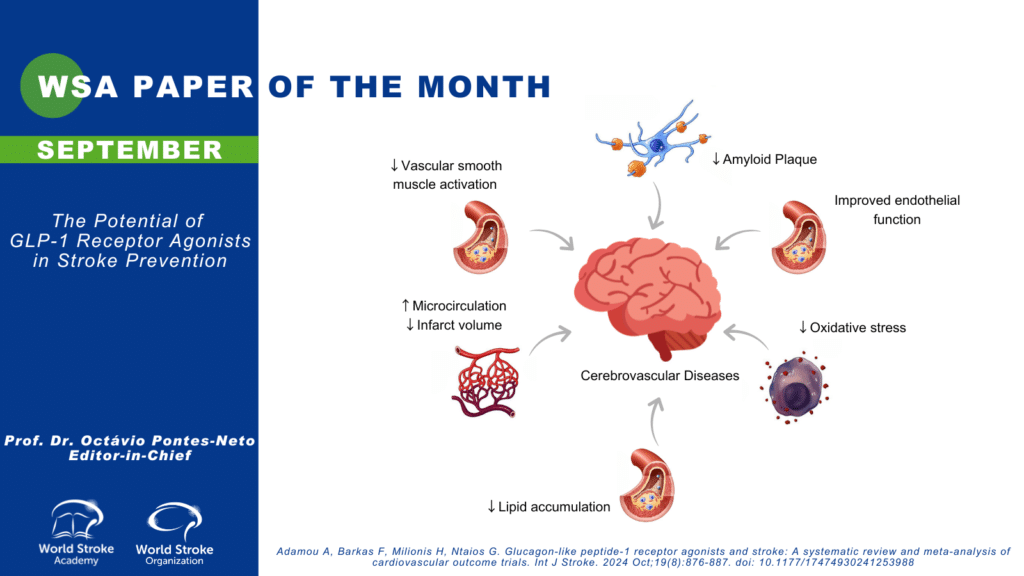The Paper of The Month – September
28 Sep 2024The Potential of GLP-1 Receptor Agonists in Stroke Prevention
The Potential of GLP-1 Receptor Agonists in Stroke Prevention
By Octavio Marques Pontes-Neto, MD, PHD – WSA Editor-in-Chief
This article is a commentary on the following: Adamou A, Barkas F, Milionis H, Ntaios G. Glucagon-like peptide-1 receptor agonists and stroke: A systematic review and meta-analysis of cardiovascular outcome trials. Int J Stroke. 2024 May 21:17474930241253988. doi: 10.1177/17474930241253988.
The global burden of stroke remains a significant public health challenge, marked by high mortality and long-term disability. Despite advances in medical interventions, the recurrence of stroke, particularly in patients with comorbid conditions like diabetes mellitus and obesity, is alarmingly high. A recent systematic review and meta-analysis published in the International Journal of Stroke by Adamou et al. has examined a promising therapeutic avenue: glucagon-like peptide-1 receptor agonists (GLP-1 RAs) for stroke prevention.1
GLP-1 RAs have been extensively studied over the past two decades for their efficacy in managing type 2 diabetes and obesity. Their benefits extend beyond glycemic control, offering cardiovascular protection and weight reduction, making them a compelling option for secondary stroke prevention. Adamou and colleagues conducted a thorough analysis of randomized cardiovascular outcome trials to assess the impact of GLP-1 RAs on stroke risk. This subject has gained traction in recent years but has not been fully explored.
The meta-analysis included 11 trials with 82,140 participants, providing robust evidence of the efficacy of GLP-1 RAs in reducing stroke risk.1 The findings are compelling: GLP-1 RAs were associated with a 16% reduction in stroke risk compared to placebo. This effect was consistent across different administration routes (oral vs. subcutaneous) and frequencies (daily vs. weekly), and it was independent of the presence of diabetes, highlighting the broad applicability of these agents in stroke prevention.
One of the most significant outcomes of the study is the reduction in non-fatal strokes, which are often precursors to more severe cardiovascular events. The analysis revealed that GLP-1 RAs reduced the incidence of non-fatal strokes by 13%, with a number needed to treat (NNT) of 250. This suggests that for every 250 patients treated with GLP-1 RAs, one non-fatal stroke could be prevented—a statistic that could translate into substantial public health benefits if these medications were more widely adopted.
However, the underutilization of GLP-1 RAs remains a critical barrier to their full potential in clinical practice. Despite their established benefits, these medications are often underprescribed, particularly in primary care settings where concerns about cost, complexity of use, and potential side effects persist. The cost of GLP-1 RAs is a consideration, but their potential for cost-effectiveness should not be overlooked. Studies have suggested that, compared to standard treatments, GLP-1 RAs offer significant cost savings, particularly when factoring in the reduction of hospitalizations and long-term care associated with stroke-related disabilities. However, further studies may be necessary in low and middle-income countries.
Adamou et al.’s study also highlights the importance of integrating GLP-1 RAs into existing guidelines for stroke prevention1. While current guidelines recommend GLP-1 RAs for managing diabetes in patients with a history of stroke, there is a clear need for more specific recommendations addressing their use in stroke prevention for patients with obesity. As evidence grows, these guidelines must evolve to reflect the latest research, ensuring patients receive the most effective care.
The limitations of the study, as acknowledged by the authors, include the lack of individual patient data and the relatively low percentage of participants with a history of stroke. Despite these limitations, the findings provide a strong foundation for future research, particularly studies focusing on patients with prior stroke. Such studies could offer more detailed insights into the role of GLP-1 RAs in this high-risk population and further refine treatment strategies.
In conclusion, the findings from Adamou et al.’s meta-analysis underscore the potential of GLP-1 RAs as a promising tool in stroke prevention, particularly for patients with diabetes and obesity.1 As the medical community continues to seek effective strategies to reduce the global burden of stroke, GLP-1 RAs offer a promising avenue that warrants further exploration and broader implementation in clinical practice.
References:
- Adamou A, Barkas F, Milionis H, Ntaios G. Glucagon-like peptide-1 receptor agonists and stroke: A systematic review and meta-analysis of cardiovascular outcome trials. Int J Stroke. 2024 May 21:17474930241253988. doi: 10.1177/17474930241253988.


